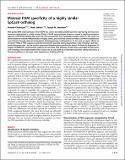Minimal PAM specificity of a highly similar SpCas9 ortholog
Author(s)
Chatterjee, Pranam; Jakimo, Noah; Jacobson, Joseph
DownloadPublished version (5.015Mb)
Terms of use
Metadata
Show full item recordAbstract
RNA-guided DNA endonucleases of the CRISPR-Cas system are widely used for genome engineering and thus have numerous applications in a wide variety of fields. CRISPR endonucleases, however, require a specific protospacer adjacent motif (PAM) flanking the target site, thus constraining their targetable sequence space. In this study, we demonstrate the natural PAM plasticity of a highly similar, yet previously uncharacterized, Cas9 from Streptococcus canis (ScCas9) through rational manipulation of distinguishing motif insertions. To this end, we report affinity to minimal 5′-NNG-3′ PAM sequences and demonstrate the accurate editing capabilities of the ortholog in both bacterial and human cells. Last, we build an automated bioinformatics pipeline, the Search for PAMs by ALignment Of Targets (SPAMALOT), which further explores the microbial PAM diversity of otherwise overlooked Streptococcus Cas9 orthologs. Our results establish that ScCas9 can be used both as an alternative genome editing tool and as a functional platform to discover novel Streptococcus PAM specificities. ©2018 The Authors, some rights reserved.
Date issued
2018-10Department
Massachusetts Institute of Technology. Center for Bits and Atoms; Massachusetts Institute of Technology. Media LaboratoryJournal
Science Advances
Publisher
American Association for the Advancement of Science (AAAS)
Citation
Chatterjee, Pranam et al., "Minimal PAM specificity of a highly similar SpCas9 ortholog." Science Advances 4, 10 (October 2018): no. eaau0766 doi. 10.1126/sciadv.aau0766 ©2018 Authors
Version: Final published version
ISSN
2375-2548